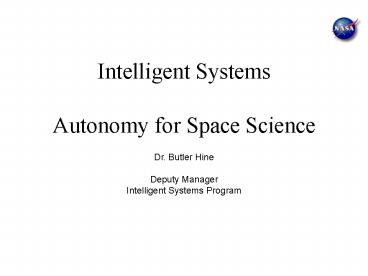Intelligent Systems Autonomy for Space Science - PowerPoint PPT Presentation
1 / 24
Title:
Intelligent Systems Autonomy for Space Science
Description:
In order to accomplish the next generation of challenging missions, NASA must ... number of ingenious strategies for perceiving their world in three dimensions ... – PowerPoint PPT presentation
Number of Views:61
Avg rating:3.0/5.0
Title: Intelligent Systems Autonomy for Space Science
1
Intelligent SystemsAutonomy for Space Science
Dr. Butler Hine Deputy Manager Intelligent
Systems Program
2
Why Autonomy?
In order to accomplish the next generation of
challenging missions, NASA must develop highly
autonomous systems capable of making critical
decisions independently of human operators, as
well as mixed-initiative ground-based systems,
that work in collaboration with humans to support
missions.
3
Classes of Missions
4
Task Hierarchy
5
Science Autonomy
- Ultimate Goal Increase Science Productivity for
Science Exploration Missions - Method Develop spacecraft capable of acting at
the level of a 1st year graduate student in the
relevant science discipline (e.g. planetary
geology) - Technical Requirements
- (1) Autonomous Health and Safety Management (e.g.
the vehicle keeps itself safe and able to
function for long periods of time) - (2) Autonomous Navigation and Path Planning (e.g.
the vehicle is able to go where it needs to, and
decide when it can't) - (3) Autonomous Robust Instrument Operation (e.g.
the ability to manipulate, operate, and process
data from a science instrument without direct
human control) - (4) Autonomous Field Work (e.g. vehicle is able
to operate multiple science instruments at a high
level, and process the data) - (5) On-Board Science Analysis and Understanding
(e.g. the vehicle can accept a goal like
"characterize this site" and can act on it by
generating and testing hypotheses... ultimately
building internal models of the environment)
6
Autonomous Science
7
Technical Driver for Autonomy RequirementsA
Europa Sub Mission to Search for Life
8
Europa - Possible Internal Structure
9
Mission Profile for a Europa Sub
- Europa landing
- Comm/Power infrastructure deployment
- Ice crust penetration
- Initial liquid characterization
- Initial mapping survey
- Normal liquid characterization
- Trace signature tracking
- Vent characterization and sampling
- Sample Analysis
10
Autonomy Requirements for a Europa Sub
- Continuous Vehicle Health Maintenance
- Mission planning
- Resource scheduling
- Environmental map building
- Tracking and navigation
- Sample collection
- Sample Analysis
- Target-of-opportunity identification
11
Two Approaches to Autonomy
- Multi-layer Architectures
- Hierarchical Control
- Deliberative Planning
- Model-based Reasoning
- Complex Computational Requirements
- Highly controllable/complex goals
- Biologically-inspired Approaches
- Highly reactive
- Distributed Control
- Simple Computational Requirements
- Less controllable/simple goals
12
Multi-layer Autonomy Architecture
Deep Space One Remote Agent Flight Experiment
13
Planning and Execution
14
Vehicle Health Maintenance
15
Results
16
Bio-inspired Approaches to Autonomy
- Emergent Behavior Architectures
- Biomorphic Navigation
- Neurally Inspired Flight Control
- Search Strategies
- Biologically-Inspired State Sensors
- Locomotion Strategies
17
Emergent Behavior Architectures
- Complex behaviors emerging from networks of
simple behaviors (e.g. Subsumption) - Emergent behavior from colonies of simple
agents - Reactive behaviors adapt rapidly to dynamic
environments - Enhanced failure-mode adaptation
18
Biomorphic Navigation
Insects (for example honey bees) cope remarkably
well with their world, despite possessing a brain
that carries fewer than 0.01 as many neurons as
humans. Although most insects have immobile
eyes, fixed focus optics(no range info) and lack
stereo vision, they use a number of ingenious
strategies for perceiving their world in three
dimensions and navigating successfully in it.
Some of these bee inspired strategies provide
unique solutions to navigation and landing for
micro-flyer applications in future missions
Honeybee Inspired landing, terrain following,
gorge following, obstacle avoidance and
point-to-point navigation
19
Neurally Inspired Intelligent Flight Control
Neurally-inspired intelligent flight control
enables real time capability to respond to
changes in aircraft stability due to varying
weather conditions and make adjustments to
maintain the best possible flight performance.
Such adaptive controls provide for on-the-fly
reconfigurability and self healing capability in
flight.
20
Search Strategy for Features of Interest
CLASS 1
CLASS 3
CLASS 2
21
(No Transcript)
22
Cellular Nonlinear Network Chips for Retinal
imaging
Incorporation of the local computation
capabilities of CNN may simplify the overall
image processing architecture to deliver
enhanced autonomous search operation
Biological Origins Recent biological studies
have confirmed that representations of each
different characteristic of the visual world is
formed in parallel, and embodied in a stack of
strata in the retina (Hubel and Wiesel,1972,
1977 Roska Werblin, 2001). Each of these
representations can be efficiently modeled in
CNN. Many of the biological image processing
operations, when translated into CNN image
processing operations, constitute algorithmic
cornerstones, useful in practical image
processing missions.
Seven of the dozen or so representations of the
visual world formed by sophisticated image
processing operations in the vertebrate retina.
Each representation extracts a different feature
from the visual world.
23
Locomotion Strategies
Behavior-Based Robots
The BEES Approach
Autonomous Robots
Rhex
Sir Arthur
Sustained Real World Behavior
MAKRO
Snake
Compliant Leg Design for Dynamical Behavior
Mechanical Design
Bioinspired Control
24
Conclusion
- Autonomous capability will be increasingly
important for future NASA missions, as we
transition from fly-by/survey science to contact
science. - There are several approaches to autonomy, not all
of which require massive processing power.

